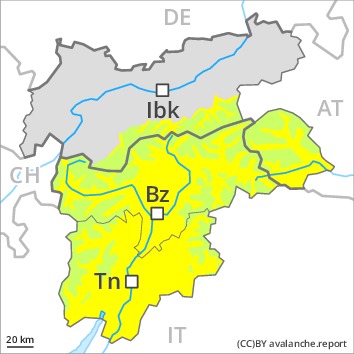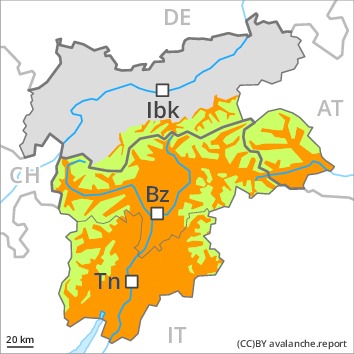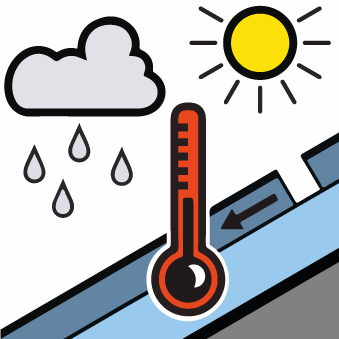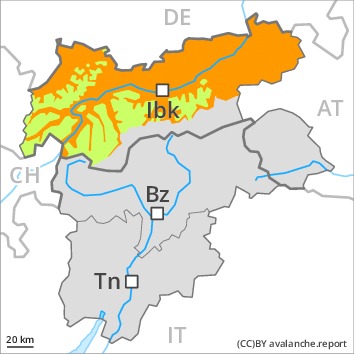AM

Danger level
 | 2600m
|
Avalanche Problem
 | | Gliding snow |
|  | |  |
 | | Wind-drifted snow |
|  | |  |
PM

Danger level
 | 2600m
|
Avalanche Problem
 | | Wet snow |
|  | |  |
 | | Wind-drifted snow |
|  | |  |
Wet avalanches as the day progresses. Fresh wind slabs require caution.
A clear night will be followed in the early morning by quite favourable conditions. Individual gliding avalanches can also be released in the night or in the morning. From the late morning as a consequence of warming during the day and solar radiation there will be an appreciable increase in the danger of wet and gliding avalanches. Caution is to be exercised in particular on very steep sunny slopes below approximately 2600 m, as well as in steep rocky terrain. Wet avalanches can release the wet snowpack and reach large size. Exposed parts of transportation routes are endangered in isolated cases. Areas with glide cracks are to be avoided. Backcountry tours should be concluded timely.
The somewhat older wind slabs are rather small and can only be released by large loads in most cases. The wind slabs are mostly easy to recognise. The avalanche prone locations are to be found in particular on very steep shady slopes above approximately 2400 m and adjacent to ridgelines. Avalanches can additionally in very isolated cases be released in deeper layers, mostly by large additional loads, especially in areas where the snow cover is rather shallow. Such avalanche prone locations are very rare.
Snowpack
dp.10: springtime scenario
dp.2: gliding snow
Outgoing longwave radiation during the night will be good over a wide area. The snowpack is moist and its surface has a melt-freeze crust that is strong in many cases. The surface of the snowpack will soften earlier than the day before. The spring-like weather conditions will give rise to increasing and thorough wetting of the snowpack, in particular on steep sunny slopes below approximately 2600 m, as well as on shady slopes below approximately 1800 m.
The somewhat older wind slabs are lying on soft layers in particular on steep shady slopes above approximately 2400 m. As a consequence of mild temperatures and solar radiation the snow drift accumulations stabilised. Isolated avalanche prone weak layers exist in the centre of the snowpack on west, north and east facing slopes.
Tendency
Wet avalanches as the day progresses. As a consequence of warming and solar radiation, the natural avalanche activity will increase.
AM

Danger level
 | 2400m
|
Avalanche Problem
PM

Danger level
 | 2600m
|
Avalanche Problem
 | | Wet snow |
|  | |  |
 | | Wind-drifted snow |
|  | |  |
Increase in danger of wet avalanches in the course of the day.
A clear night will be followed in the early morning by quite favourable conditions, but the danger of wet avalanches will increase later. In the afternoon, a few, then more, and in some cases even large, wet and gliding avalanches are to be expected, especially on very steep sunny slopes below approximately 2600 m, as well as in steep rocky terrain. Areas with glide cracks are to be avoided. Exposed parts of transportation routes can be endangered occasionally. Backcountry tours should be started early and concluded timely.
As a consequence of the moderate to strong southerly foehn wind, fresh snow drift accumulations formed during the last few days. These can be released by a single winter sport participant in isolated cases especially on very steep shady slopes above approximately 2400 m. Caution is to be exercised in particular adjacent to ridgelines.
Snowpack
dp.10: springtime scenario
dp.6: cold, loose snow and wind
Outgoing longwave radiation during the night was good over a wide area. The surface of the snowpack will freeze to form a strong crust and will soften during the day. The high temperatures will give rise to increasing and thorough wetting of the snowpack, in particular on steep sunny slopes below approximately 2600 m, as well as on shady slopes below approximately 1800 m.
The mostly small wind slabs of the last few days are lying on soft layers in particular on steep shady slopes above approximately 2400 m. As a consequence of mild temperatures and solar radiation the snow drift accumulations stabilised. Isolated avalanche prone weak layers exist in the centre of the snowpack. At low altitude a little snow is lying.
Tendency
Increase in danger of wet avalanches as a consequence of warming during the day.


















